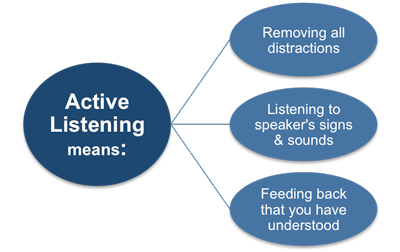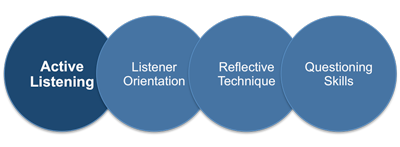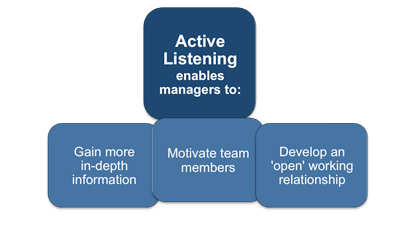Active Listening Skills - Advantages of Active Listening
Active listening enhances your ability to absorb and pass on the data and information given during the exchange. By developing your skills and techniques to actively listen your communications will offer your listeners greater clarity and empathy.
 |
An essential aspect of active listening is your ability to block out any distractions that may be present where you are communicating. By giving 100 percent to your conversation you will hear and comprehend the true content of the message as well as being able to pick up all the unconscious signs displayed.
If your natural tendency is to rush into a response, practice taking a breath before you talk so that the other person has the opportunity to finish what they are saying. If don't do this and you cut off the person's response before they have explained their whole viewpoint you will not have a complete picture. Beware of this and the many other barriers you must avoid to gain the benefits of active listening.
Without the whole picture of the discussion you are more likely to misinterpret the exchange. To keep your focus on what is being said to you give the speaker signs that they have your full attention by slightly moving your head or eyes. You may also need to ask others in the situation to be quiet so the speaker can express themselves.
By behaving in this way you will be able to put together more persuasive replies and achieve your communication objective. It also illustrates your understanding of the speaker's viewpoint and how this relates to your own beliefs.
By paying attention to the other person's responses you will be able to accurately judge their topic knowledge and adjust your communication style appropriately. You also have the opportunity to feed back to the individual that you have comprehended what they are saying to you.
This makes them feel valued and willing to contribute further, and ensures the exchange is a two-way process. This can be achieved by simply following your summation of what they have said with such phrases as:
• Does that make sense to you?
• What do you think?
• Would you agree?
• What's your view on this?
In addition, you can encourage another person to make a contribution to your exchange by using a pause or remaining silent. This offers you two advantages. First, it gives you as the listener time to pull your thoughts together, and secondly, people have an innate desire to fill a void, so they begin to speak.
 |
The two-way communication active listening encourages also provides you with the opportunities to give reasoned and valid feedback, as well as allowing you to gain clarification of what you believe has been said to you.
This is one of the techniques that enable you to minimize the distractions that can occur during an exchange or dialogue. Being able to retain the focus of the communication on your objective is essential for success. An important side effect of such behavior is that others will follow your lead when conducting their own communications.
By developing your abilities to use all three components of active listening - listening orientation, reflective technique, and questioning skills - you will be able to maximize the effectiveness and productivity of the individuals in your team.
Active listening is a skill that can be acquired and developed with practice. However, active listening can be difficult to master and will, therefore, take time and patience. Used appropriately, active listening may provide three very positive results:
 |
Firstly, the listener gains information because active listening encourages the speaker to talk about more things in greater depth than he or she would be likely to do in simply responding to directive questions or suggestions. Such depth of discussion often exposes underlying problems, including ones the speaker had not recognized previously.
Secondly, the elements of listening orientation (empathy, acceptance, congruence, and concreteness) are likely to increase as the reflective listening process continues. These are the ingredients you need for an open, trusting relationship with your team members.
Finally, active listening stimulates and channels motivational energy. As the listener, you accept and encourage the speaker, but you leave the initiative in their hands. Consequently, your team member will recognize new avenues for action and will begin making plans to pursue them, making themselves more effective and productive.
You may also be interested in:
Active Listening Skills for Managers | Definition of Active Listening | Reflective Technique | Questioning Skills | Barriers to Active Listening.
|
|
 |


